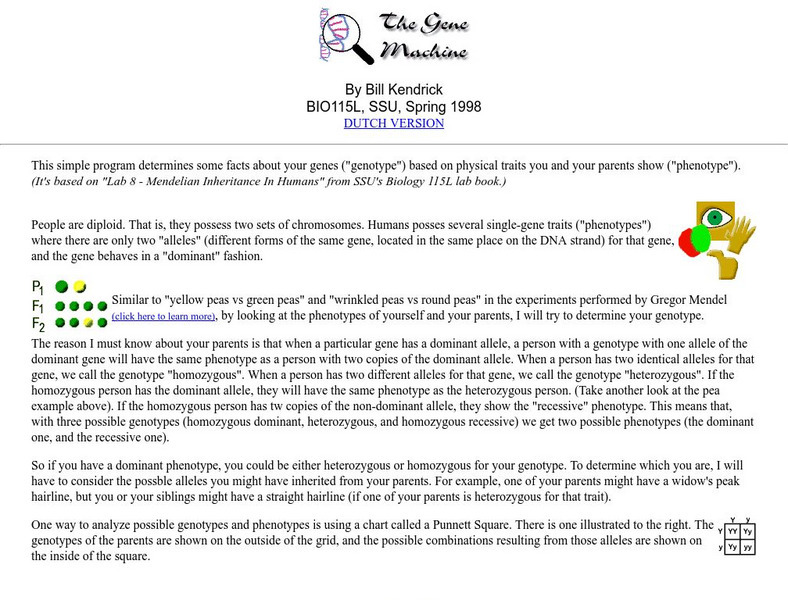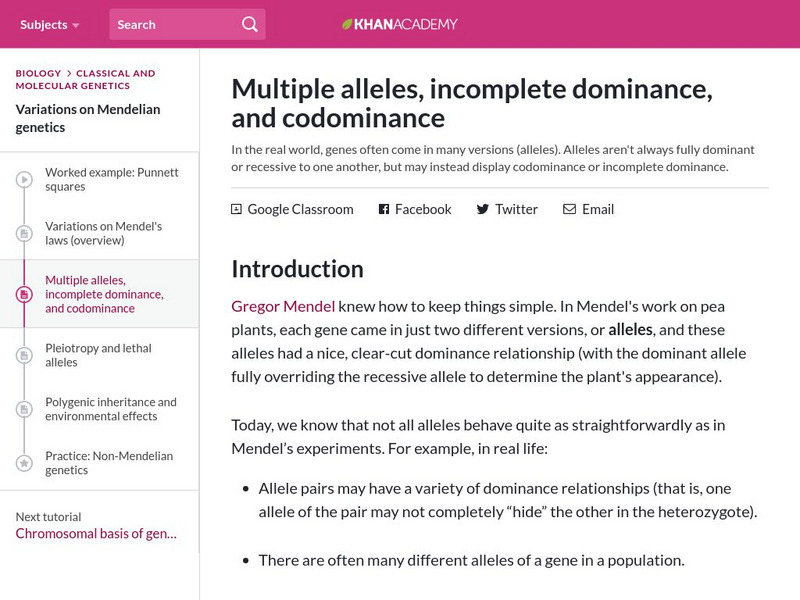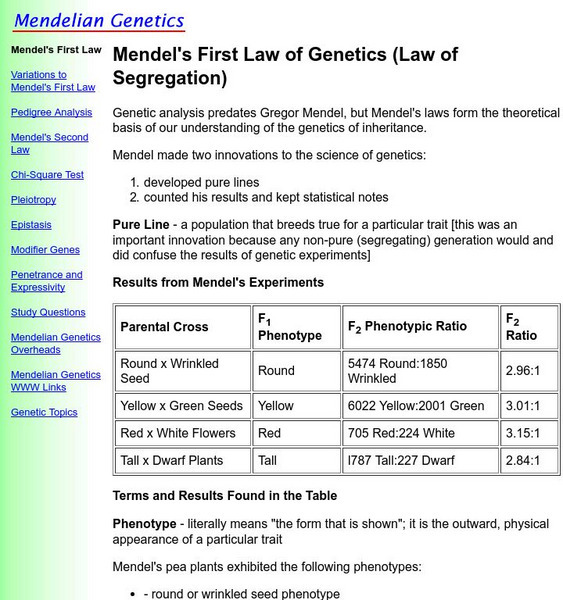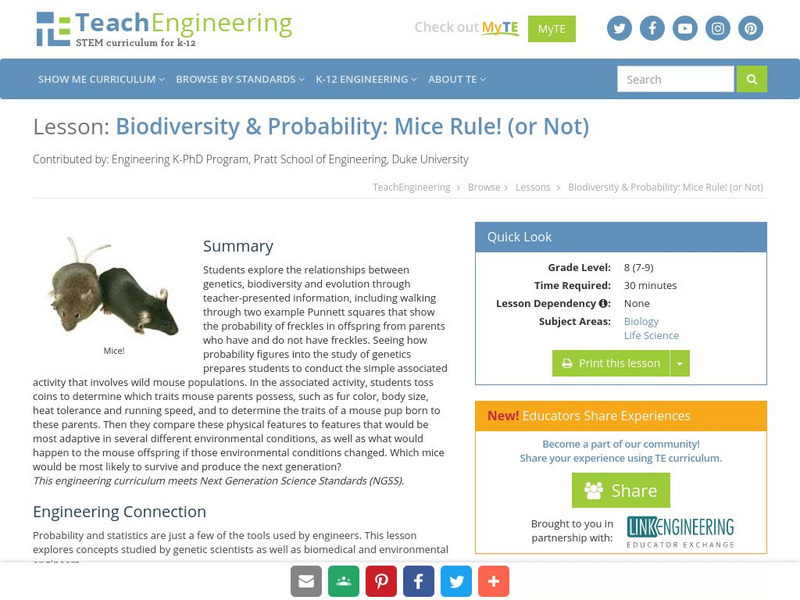ArtsNow
Arts Now Learning: The Gene Connection Show [Pdf]
Fifth graders will discover the difference between inherited traits and learned behaviors by bringing the traits to life in a game of charades. After that, the students will demonstrate knowledge of recessive and dominant traits as they...
Vision Learning
Visionlearning: Genetics: Gene Expression
Explore the connection of genes and enzymes in regards to heredity and genetics. Concepts associated with dominant and recessive traits are also presented.
BiologyWise
Biology Wise: Dominant and Recessive Traits in Humans
Explains what dominant and recessive traits are and how they work, and provides a list of single gene traits with the degree of manifestation if they are dominant or recessive. Also discusses co-dominance, incomplete dominance, polygenic...
Other
Biology Project: The Gene Machine
Site allows users to learn interesting information about their genes based on his/her physical traits. Provides a brief explanation of how a person's genotype is determined.
Center for Innovation in Engineering and Science Education, Stevens Institute of Technology
Ciese: Human Genetics Project: Is the Dominant Trait Most Prevalent?
Human-Genetics: A Worldwide Search for the Dominant Trait allows you to collect data and share your results with students around the world. Register your class, complete the student survey, participate in discussion boards, and interact...
PBS
Pbs Learning Media: Some Genes Are Dominant
This interactive activity, adapted from the Dolan DNA Learning Center, illustrates how Gregor Mendel used purebred yellow and green peas to show that some genes are dominant and others are recessive.
Khan Academy
Khan Academy: Multiple Alleles, Incomplete Dominance, and Codominance
In the real world, genes often come in many versions (alleles). Alleles aren't always fully dominant or recessive to one another, but may instead display codominance or incomplete dominance.
National Cancer Institute at the National Institutes of Health
National Cancer Institute: What Are Gene Mutations?
This website provides an answer to the following question: "What are Gene Mutations?" Many links are provided throughout this short description that access information on related subjects.
TeachEngineering
Teach Engineering: What's Dominant?
In a class discussion format, the teacher presents background information about basic human genetics. The number of chromosomes in both body cells and egg and sperm cells is covered, as well as the concept of dominant and recessive...
The Association of the British Pharmaceutical Industry
Abpi: Genes and Inheritance
A complete, student-paced lesson on genetics and inheritance. Students work their way through illustrations and animated tutorials, and answer review questions along the way. There is a self-checking quiz at the end of the lesson.
University of Hamburg
University of Hamburg: Deviations From Mendelian Laws And: What Is the Meaning of Dominance?
Upper level discussion of several of Mendel's experiments and laws.
Oklahoma State University
Oklahoma State University: Ag in the Classroom: Hairy Heredity [Pdf]
A simulation where students flip coins to mimic how parents pass genetic traits to their offspring through heredity. This activity also illustrates the difference between dominant and recessive genes, and how they interact with each...
PBS
Pbs: Our Genes/our Choices: The Probabilities of Problems: A Look at Inheritance
Learn how the genes inherited from two parents can be recombined in their offspring in this simulation activity. In addition, investigate the probabilities of passing on inherited genetic disorders.
Cold Spring Harbor Laboratory
Dna From the Beginning: Classical Genetics
This article from DNA from the beginning is loaded with goodies about genetics and DNA. Starting with Mendel all the way through the concept of DNA, you will see how life is given certain characteristics. Some animations and audio clips...
TeachEngineering
Teach Engineering: The Benefits of Biodiversity
First, students toss coins to determine what traits a set of mouse parents possess, such as fur color, body size, heat tolerance, and running speed. Next they use coin tossing to determine the traits a mouse pup born to these parents...
Other
North Dakota State: Mendel's First Law (Law of Segregation)
This resource explains Mendel's first law (Law of Segregation) in detail. Includes Mendel's original experiments with results and conclusions.
Palomar Community College District
Palomar College: Practice Quiz for Mendelian Genetics
This site from Palomar College provides an online practice quiz includes history as well as some of the genetics. Includes feedback. A great learning and practice site.
Other
Lawrence Livermore National Lab: Probabilities of Traits
This site explains how to determine the chances of inheriting certain traits from our parents. It gives mathematical examples and exercises.
Other
Explore Learning: Mouse Genetics: Two Traits
Breed pure mice with known genotypes that exhibit specific fur and eye colors, and learn how traits are passed on via dominant and recessive genes. Punnett squares can be used to predict results. (Free usage is limited to five minutes...
Science Buddies
Science Buddies: Pedigree Analysis: A Family Tree of Traits
Some characteristics, like the shape of your hairline, whether your earlobes are attached or detached, and whether or not you have freckles are inherited from your parents. In this science project you will learn about Mendelian traits,...
TeachEngineering
Teach Engineering: Mice Rule! (Or Not)
Students explore the relationships between genetics, biodiversity, and evolution through a simple activity involving hypothetical wild mouse populations. First, students toss coins to determine what traits a set of mouse parents...
Ducksters
Ducksters: Biology for Kids: Hereditary Patterns
A site with information about the hereditary patterns in the science of biology including dominant and recessive genes, alleles, the Punnet square, examples, and interesting facts.
University of Maryland
Univ. Of Maryland Baltimore Cty/biology Century
Historical perspective on Mendel's contribution. Spends a little time setting up what the current beliefs of Mendel's day were and how he changed things with what he did.
Estrella Mountain Community College
Estrella Mountian College: Introduction to Genetics
This site explains genetic beliefs before and after Mendel, and also includes a section on Mendel himself and his experiments, entitled, "The Monk and his Peas".
Other popular searches
- Dominant and Recessive Genes
- Dominate and Recessive Genes
- Dominant Recessive Genes
- Dominant/recessive Genes
- Dominant & Recessive Genes
- Dominant Recessive Genes
- Dominant vs Recessive Genes
- Dominant Nd Recessive Genes
![Arts Now Learning: The Gene Connection Show [Pdf] Lesson Plan Arts Now Learning: The Gene Connection Show [Pdf] Lesson Plan](https://d15y2dacu3jp90.cloudfront.net/images/attachment_defaults/resource/large/FPO-knovation.png)
















